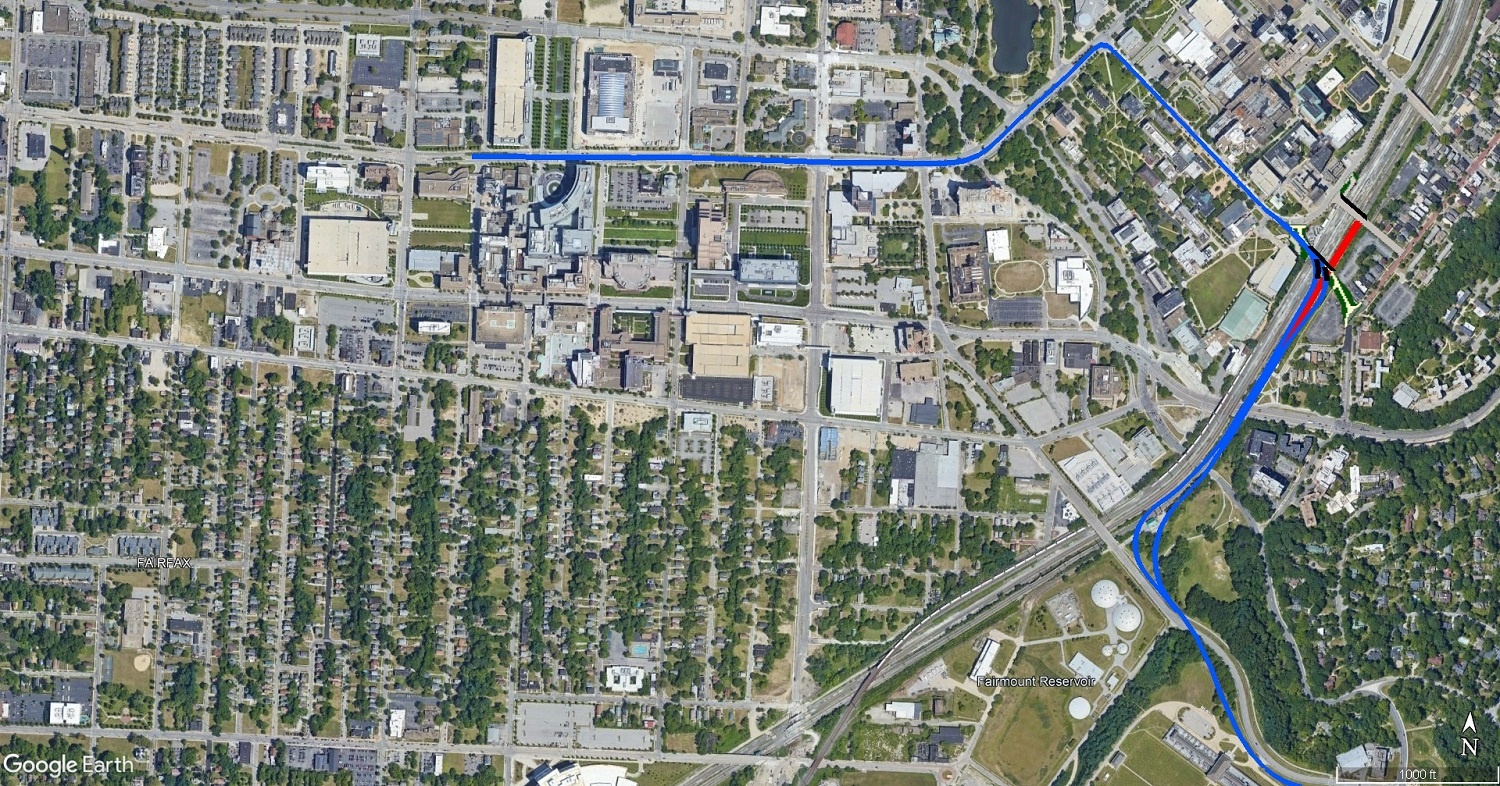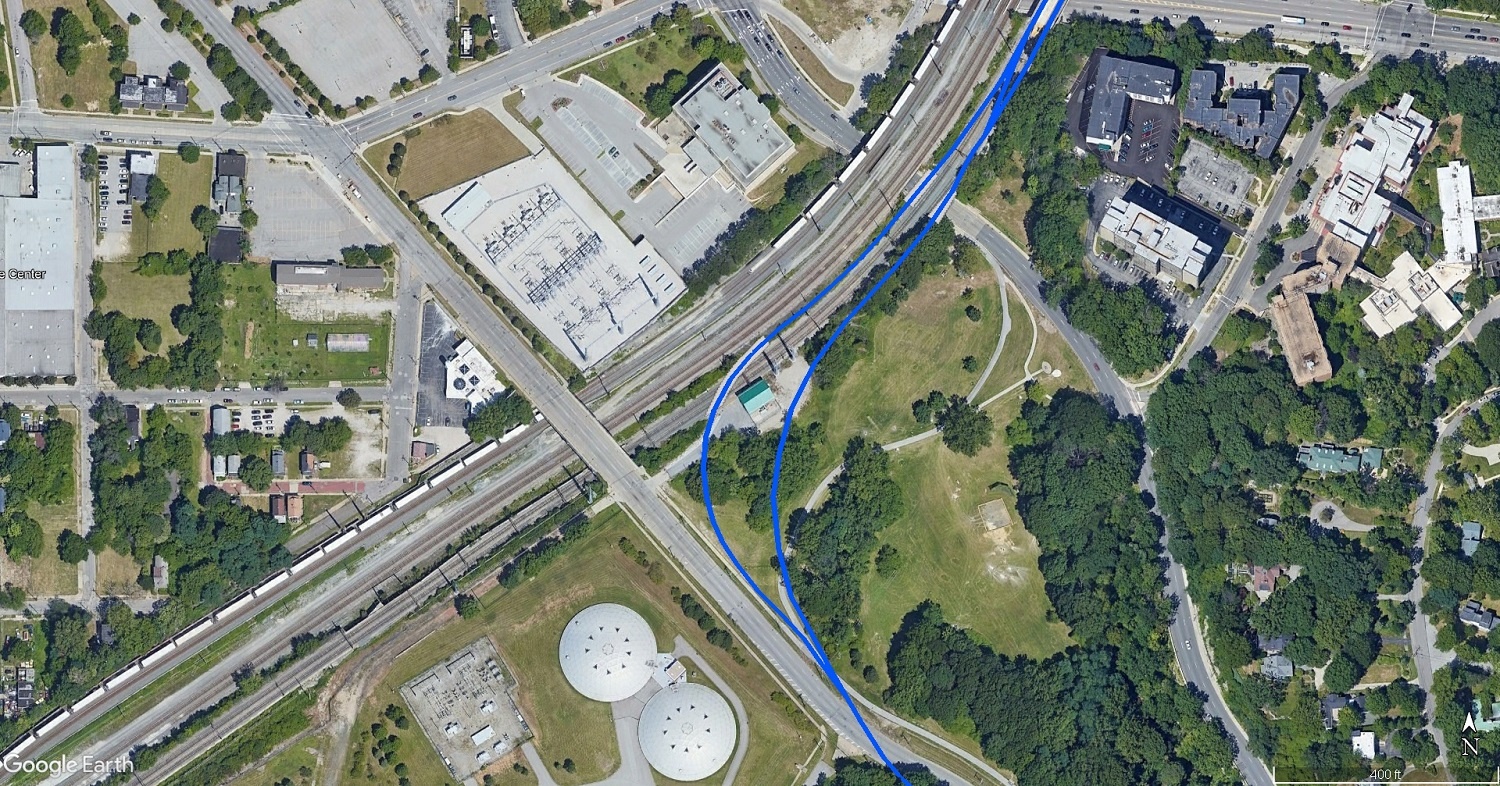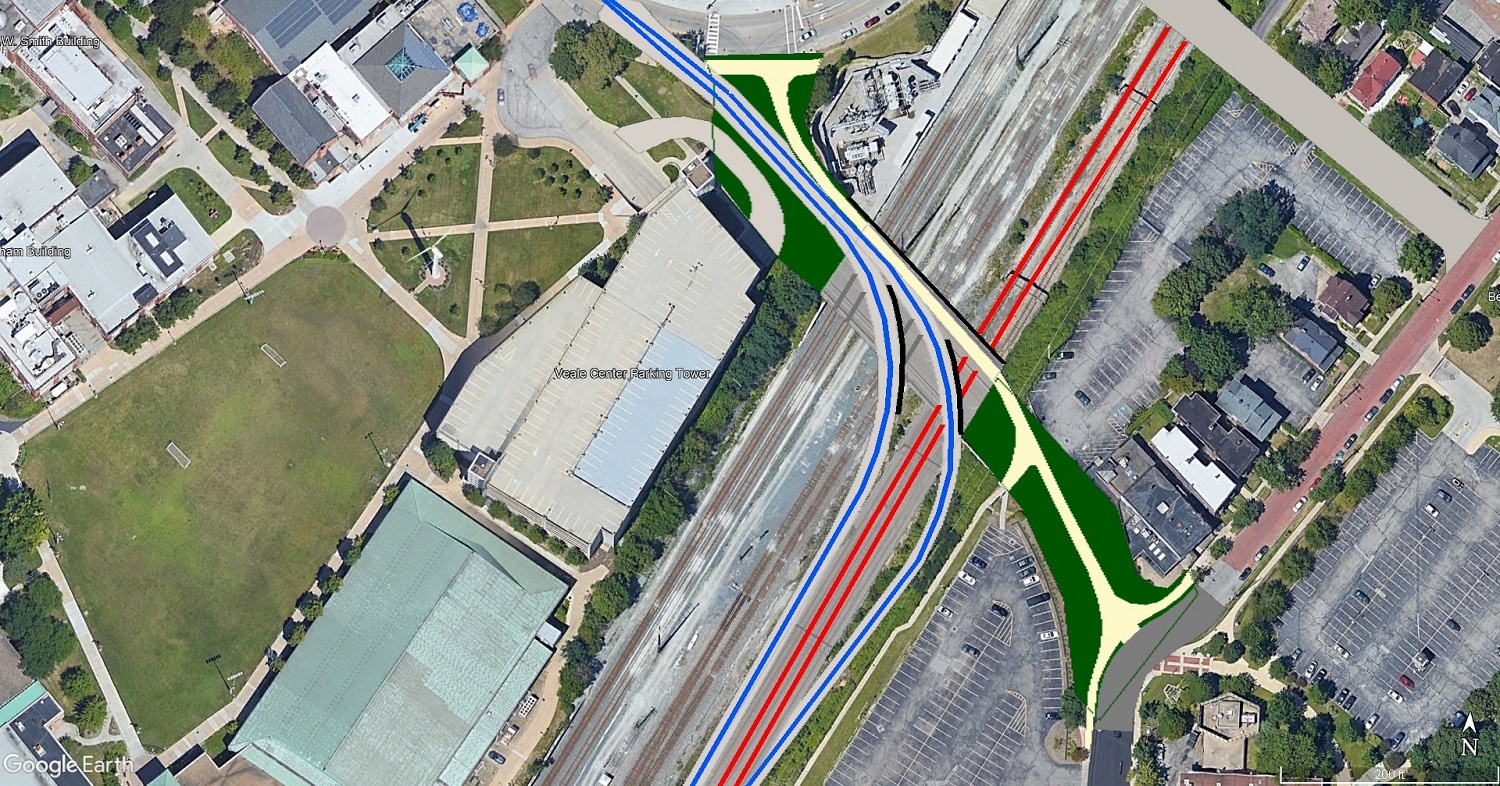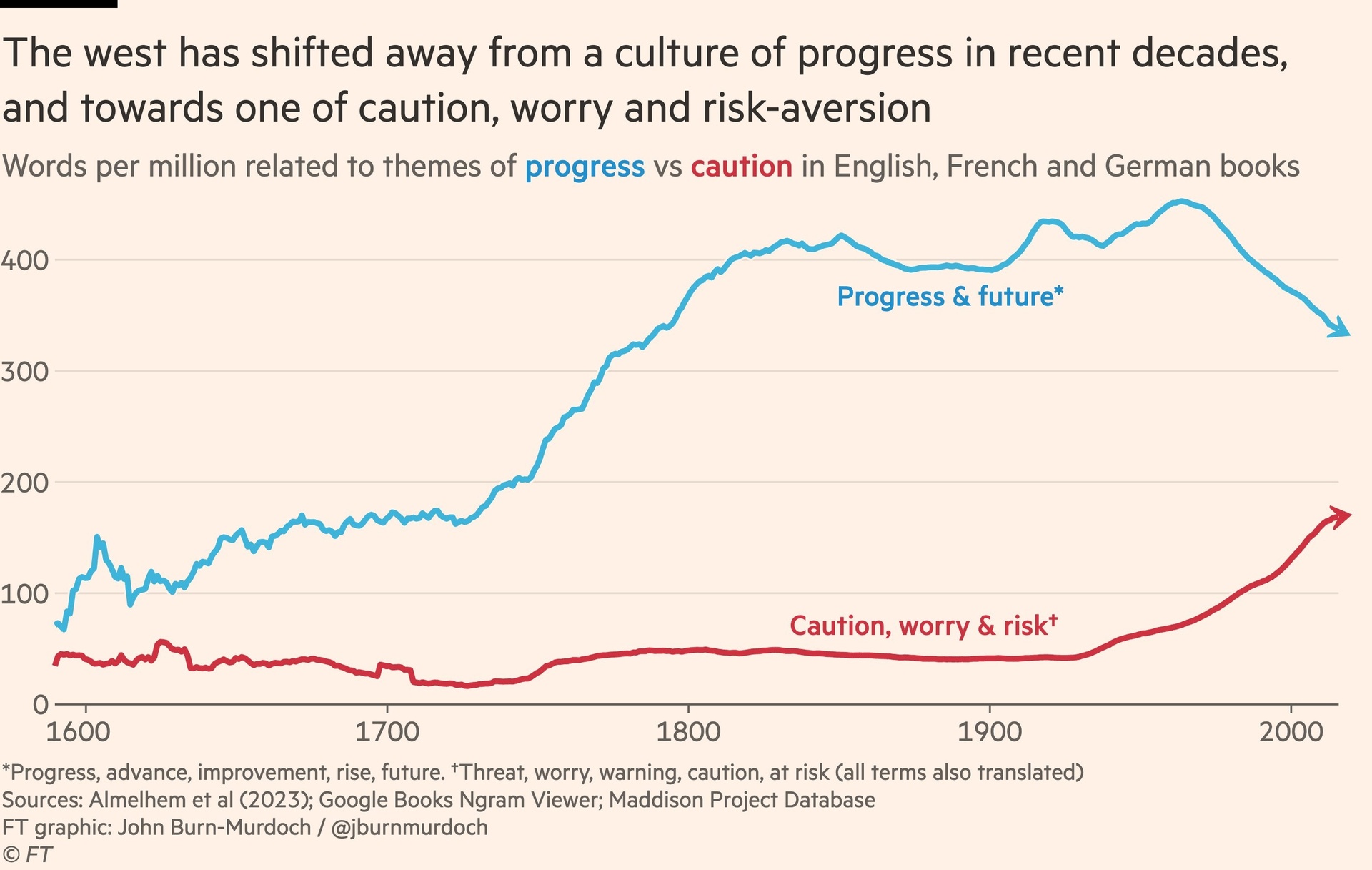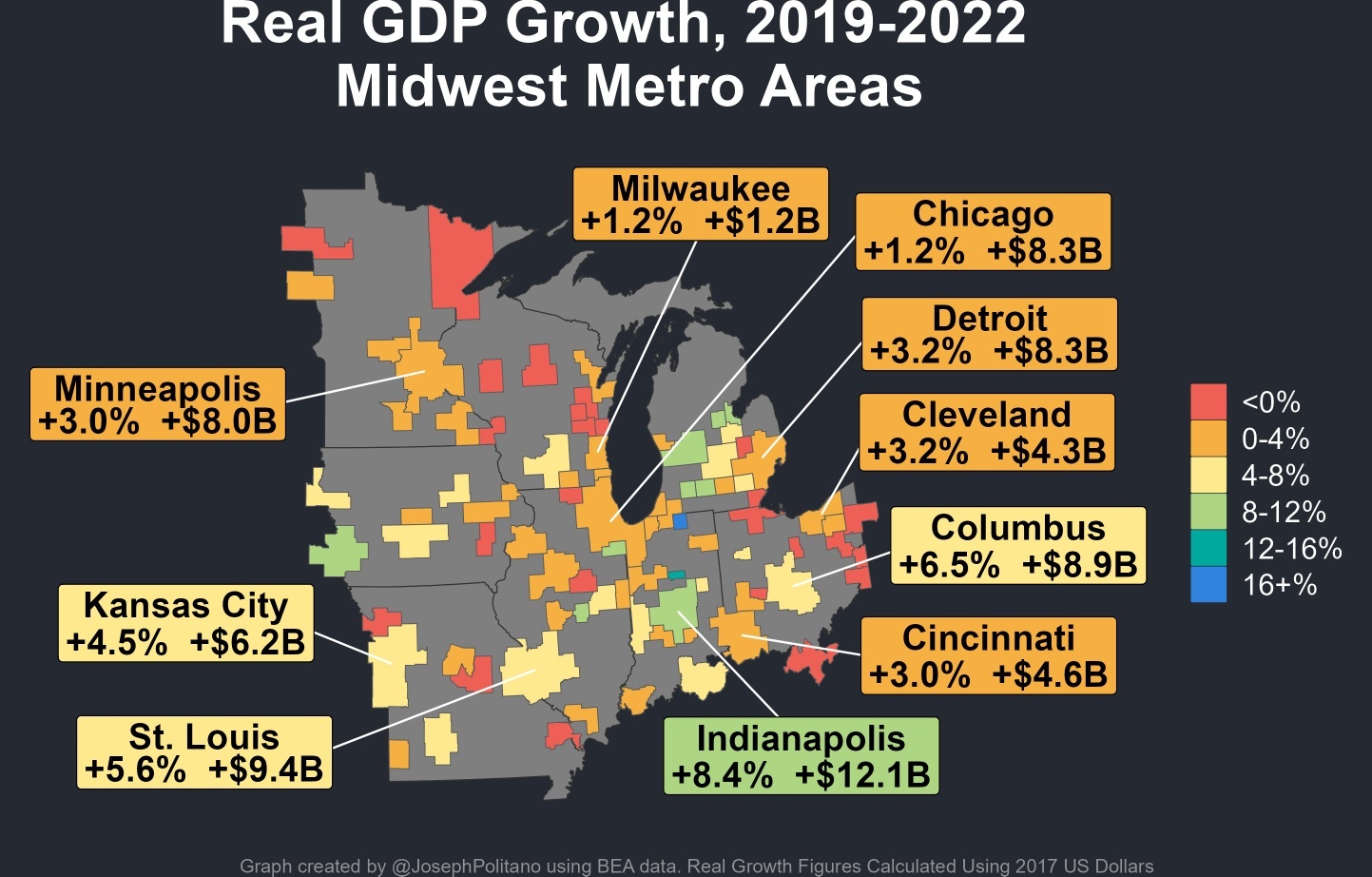
KJP
Premium Member
-
Joined
-
Last visited
-
Currently
Viewing Forum: Northeast Ohio Projects & Construction
Everything posted by KJP
-
Cleveland: Transit Ideas for the Future
I have some detailed RTA maps and other info about the Shaker Connector. When I get back home this evening I'll post them.
-
Cleveland: Transit Ideas for the Future
In the late 1990s, GCRTA's Dual Hub consulting team estimated the "Shaker Connector" would cost about $70 million, IIRC. Ironically that's how much the Waterfront Line cost. Imagine if we had built the Shaker Connector instead! Anyway, the Bureau of Labor Statistics' inflation calculator says $70 million in the late 90s is about $135 million today. Since infrastructure projects are inflating faster, I went with $150 million. And it would cost more than that since we're not building it right now, and the routing is longer, going via Adelbert and farther into Cleveland Clinic than the Shaker Connector would have.
-
Cleveland: Transit Ideas for the Future
Let me charge my crystal ball. In all seriousness, nothing I've proposed or led a lobbying effort for has ever happened (except for Amtrak's Pennsylvanian extension that lasted less than five years 1998-2003). Amtrak screwed that up and I gave up on passenger rail advocacy for about five years after that train died (er, after Amtrak murdered it).
-
Cleveland: Transit Ideas for the Future
I opted for the routing north from Shaker Square because I thought it might be cheaper than building the two track ramps and one rail bridge over the remaining Green Line at East 116th. The dense housing and east end of the Larchmere District north of Shaker Square was a bonus. The two-track routing including track ramps north from Shaker/East 116th to Stokes/East 116th is about 4,200 feet vs about 6,300 feet from Shaker Square to Stokes/East 116th.
-
Cleveland: Transit Ideas for the Future
So I made a casual comparison in a NEOtrans article recently that the cost of the Cleveland Clinic building another 3,000-space parking garage like the one at East 105th and Cedar could cost about $75 million, equal to 40-50 percent share of the cost of extending the Blue Line from Shaker Square to Cleveland Clinic. I got a bit of reader interest in that. Of course, other stakeholders should contribute shares (or lobby state officials to provide it instead) to a rail extension too (ie: University Hospitals, Case Western Reserve University, ODOT, RTA etc). Maybe even leverage some federal funds, too (or not, to simplify things and reduce costs!). Cleveland Clinic execs have told me in interviews they HATE having to build and maintain these massive parking garages and decry the Red Line because it doesn't go near them. Well.... I think, given the growth that's happening at UC, this is the most important rail extension GCRTA should consider and could offer some interesting route combos in conjunction with the new LRT fleet.... Blue Line extension to Cleveland Clinic via UHHS/CWRU, followed by Blue Line extension to I-271/Highland Hills, Downtown Loop, Euclid Red Line extension (phase 1 to Nottingham/Highland), Convert 3 miles of the HealthLine between Cleveland Clinic to the Downtown Loop to rail, Build a Red Line branch to Rocky River, then possibly to Westlake, Extend Green Line to Beachwood Place via John Carroll University. Each of these are 2-4 miles long, costing about $200 million to $500 million each. We need a countywide sustainable local revenue source for all of this, such as replacing a property tax with a land value tax. ###
-
Other States: Passenger Rail News
There's only one qualified supplier on this list. Ask Amtrak. And its USA factory is in Sacramento, California. NEWS RELEASE: High-Speed Rail Authority Releases Shortlist of Potential Suppliers for Electrified High-Speed Trains in California https://hsr.ca.gov/2024/01/05/news-release-high-speed-rail-authority-releases-shortlist-of-potential-suppliers-for-electrified-high-speed-trains-in-california/
-
Cleveland: Downtown: Sherwin-Williams Headquarters
They wished they had.
-
Cleveland: Downtown: Sherwin-Williams Headquarters
I knew that was coming. Run, @YABO713. Run far.
-
Greater Cleveland Taxation
Convert the county property tax to a land value tax and use it to fund expansion of GCRTA's rail and BRT system in 2- to 4-mile chunks that cost $200 million to $500 million each.
-
Youngstown-Warren: Random Development and News
Kimberly-Clark is buying more property, including the right of way of a newly-built railroad line. I have to wonder if this is being done to give CSX access to the plant site? Ironically, CSX abandoned its Newton Falls Secondary into Warren just a couple of years ago!
-
Why are young people driving less?
Throughout the rich world, the young are falling out of love with cars That could have big political ramifications https://www.economist.com/international/2023/02/16/throughout-the-rich-world-the-young-are-falling-out-of-love-with-cars
-
Cleveland: Glenville: Development and News
Glenville civil rights site may become homes, park By Ken Prendergast / January 5, 2024 When the Cleveland Metropolitan School District put 19 former school properties up for sale in 2021, some of them had school buildings on them. Even those that didn’t anymore still had historical value to them. One of those was the former site of the Stephen E. Howe Elementary School in Cleveland’s Glenville neighborhood which was the scene of a fatal incident in the fight for desegregation of the school district. MORE: https://neo-trans.blog/2024/01/05/glenville-civil-rights-site-may-become-homes-park/
-
Ohio Intercity Rail (3C+D Line, etc)
The point is.... the public benefit resulting from a well-designed passenger rail service exceeds the public investment in it. Fear is the enemy of progress. All growth requires risk. Western civilization used to not be so afraid of taking risks. Not so coincidentally, we were more successful then.
-
Ohio Intercity Rail (3C+D Line, etc)
Infrastructure ownership/capital financing/maintenance/operation/insurance/traffic management/security Passenger rail: mostly private Its competition: mostly public Vehicle ownership/capital financing/maintenance/operation/insurance/security Passenger rail: mostly public Its competition: mostly private The reversal of roles makes a huge difference in how easily passenger rail's competition is usually only responsible for unit operating costs and not fixed costs, thus externalizing most of its costs (infrastructure) onto taxpayers. Rail's competition can more quickly respond to the market and grow. Or it can shrink and actually save money during downturns and still have the infrastructure remain in good quality when it's time to grow again. It remains a conscious decision (including by the backward railroads themselves), in the USA to saddle railroads with huge fixed costs.
-
Cleveland: Hough: Development and News
That's this development..... https://neo-trans.blog/2022/01/05/league-park-mixed-use-development-planned/
-
Cleveland: Retail News
The formerly proposed outlet shoppes on the Muny Lots! 😜 Even at 25 percent of size, it's still a 75,000 SF store (based on IKEA's 300k typical size).
-
Cleveland: Random Development and News
They're a Ukrainian-American owned company too.
-
Ohio Abortion / Reproductive Health News
Evil is forcing their religion on us Ohio’s lawless, gerrymandered politicians cooking up another outrageous scheme: “The bill would make it so the Ohio General Assembly, not the courts, would have exclusive authority over implementing Issue 1, which covers reproductive decisions.” https://www.wlwt.com/article/ohio-issue-1-abortion-reproductive-rights-new-bill/46285727
-
Cleveland: University Circle (General): Development and News
These round-up stories are brutal to do. Only one more to go after this.... Cleveland development: what to look for in 2024 — University Circle By Ken Prendergast / January 4, 2024 Back when Cleveland was an industrial powerhouse, few wanted to live near its dirty, noisy industries. Today, its largest source of employment is the education and health services sector — a cleaner industry to which it’s attractive to live within a short walk or bike ride. It is centered in and near University Circle, surrounded by long-neglected neighborhoods. But investment has been coming into those places — Hough, Fairfax, Glenville, Cleveland Heights’ Top of the Hill, and East Cleveland’s Circle East — bolstering them as neighborhoods of choice. MORE: https://neo-trans.blog/2024/01/04/cleveland-development-what-to-look-for-2024-university-circle/
-
US Economy: News & Discussion
-
Ohio: General Business & Economic News
And most of that growth is occurring in the metro areas... https://neo-trans.blog/2023/12/12/cuyahoga-countys-economy-surges/
-
Cleveland: Random Development and News
Thanks as always for the pics, @Agreene! Cleveland development: what to look for 2024 — Downtown By Ken Prendergast / January 2, 2024 For many in the real estate investment community, 2023 was the year when few new big projects were financed. The projects that were already financed under better, prior market conditions saw their construction advance, making the real estate landscape appear rosier than it really was. Now, however, as we enter 2024, there is a light at the end of the tunnel with developers already reviving or making new plans. MORE: https://neo-trans.blog/2024/01/02/cleveland-development-what-to-look-for-2024-downtown/
-
Amtrak & Federal: Passenger Rail News
2023 Was A Good Year For American High Speed Rail. But, while some believe the dream of U.S. high-speed rail is finally within reach, the reality is America is still worlds from boasting a high-speed rail network like those found in Asia and Europe. The reason is simple—cost…. Given the current size of the Federal deficit, and the absence of a direct source of funding (highways, by contrast, are directly funded by the gas tax), high-speed rail boosters need to focus on improving construction efficiency. That means enacting several major reforms that will make the investments from the Bipartisan Infrastructure law go further. https://www.forbes.com/sites/paulweinstein/2023/12/21/2023-was-a-good-year-for-american-high-speed-rail/?sh=46ce7297787d Why 2023 emerged as a banner year for passenger rail. There are lots of reasons for optimism among passenger rail advocates. The splashiest of those came in recent months, as the Biden administration finally unveiled its vision for passenger rail expansions paid for through the 2021 infrastructure law. Going into a reelection campaign, President Joe Biden placed big bets on a few massive rail expansion efforts—particularly in the Northeast and California—while stoking interest in dozens of other potential projects in nearly every state…. Amtrak notched a significant victory as it fought freight railroads to better accommodate passenger trains. Two freight carriers agreed to allow Amtrak to revive its Gulf Coast line rather than risk an adverse ruling from a powerful regulatory panel…. Meanwhile, a stalled effort in Congress to slash Amtrak’s operations budget could show that the appetite on Capitol Hill for starving the passenger rail service might be waning. https://www.route-fifty.com/infrastructure/2023/12/why-2023-emerged-banner-year-passenger-rail/392994/ Time to get real on the bullet train: California is building it, so let’s make it work. The ambitious project has been widely lampooned over the years by many, including me, as a too-costly boondoggle and off track from the start. But let’s get real: This giant adult toy is going to be constructed one way or another, whether at reasonable speed or in pokey chug-chug fashion. It’s time we acknowledge that and focus on making it work the best for everyone. And sooner the better. You don’t spend $11 billion on a project, as California already has, then abandon it. https://www.latimes.com/california/story/2023-12-25/california-high-speed-rail-federal-funding-newsom-biden Shelved Penn Station fixes could avoid $17 billion expansion — if transit agencies actually work together: Post investigation. The MTA and NJ Transit — which operate the region’s commuter railroads — each prepared plans that collectively could double the number of trains Penn Station can fit, which experts and activists said would alleviate the need for the new terminal…. The problem with the alternate proposals is the fractious relationship between the MTA and NJT, as well as Amtrak, which owns Penn Station, according to interviews with experts, officials, and activists. The railroads have pursued the planned eye-wateringly expensive expansion because each wants room for their own independent operation inside of Penn Station instead of being forced to cooperate more closely, a document shows. https://nypost.com/2023/12/25/metro/shelved-penn-station-fixes-could-avoid-17b-expansion-docs/ Washington state lawmakers reaffirm support of high speed rail service. Washington state’s delegation in the House of Representatives recently sent a letter to Federal Railroad Administration (FRA) Administrator Amit Bose to express its support of high speed rail and improved intercity passenger rail service in Washington and the Pacific Northwest…. “Cities and counties across the nation want more frequent and more reliable intercity passenger rail service, and the Pacific Northwest is no exception,” the letter said. “The combined population of Seattle, Washington, Portland, Oregon, and Vancouver, British Columbia, is expected to grow by up to 4 million people by 2050. Reliable and efficient passenger rail service is and will continue to be essential to connecting communities across Washington.” https://transportationtodaynews.com/news/31954-washington-state-lawmakers-reaffirm-support-of-high-speed-rail-service/ Amtrak issues Request for Proposals to replace bilevel long-distance equipment. Amtrak has issued a formal Request for Proposals for replacement of its bilevel long-distance railcar fleet, outlining requirements for what it says will be a multi-billion-dollar order for equipment projected to enter service in the early 2030s…. The request is for bilevel equipment, “as it is Amtrak’s highest priority to replace the oldest portion of the long distance fleet,“ Amtrak spokesman Marc Magliari said in an emailed response to questions from Trains News Wire….” The plan is to order trainsets rather than individual cars. https://www.trains.com/trn/news-reviews/news-wire/amtrak-issues-request-for-proposals-to-replace-bilevel-long-distance-equipment/
-
Greater Cleveland Taxation
How is that growth possible?
-
The anti-rail hitmen are still out there
Wendell Cox is a toxic tool for the petroleum, automotive and road-building industries. He was actually named to the Amtrak Reform Council by GOP members of Congress as a poison pill. In my former capacity at All Aboard Ohio, I sent him and other members of the council polite suggestions on how to fund/improve/reform Amtrak. Cox told me not to send him anything and then blocked me, causing my reply (ie: "you don't want to hear any reform ideas?") to bounce back to me as unread. After that, I began to refer to people who parroted his BS as Cox Suckers.








